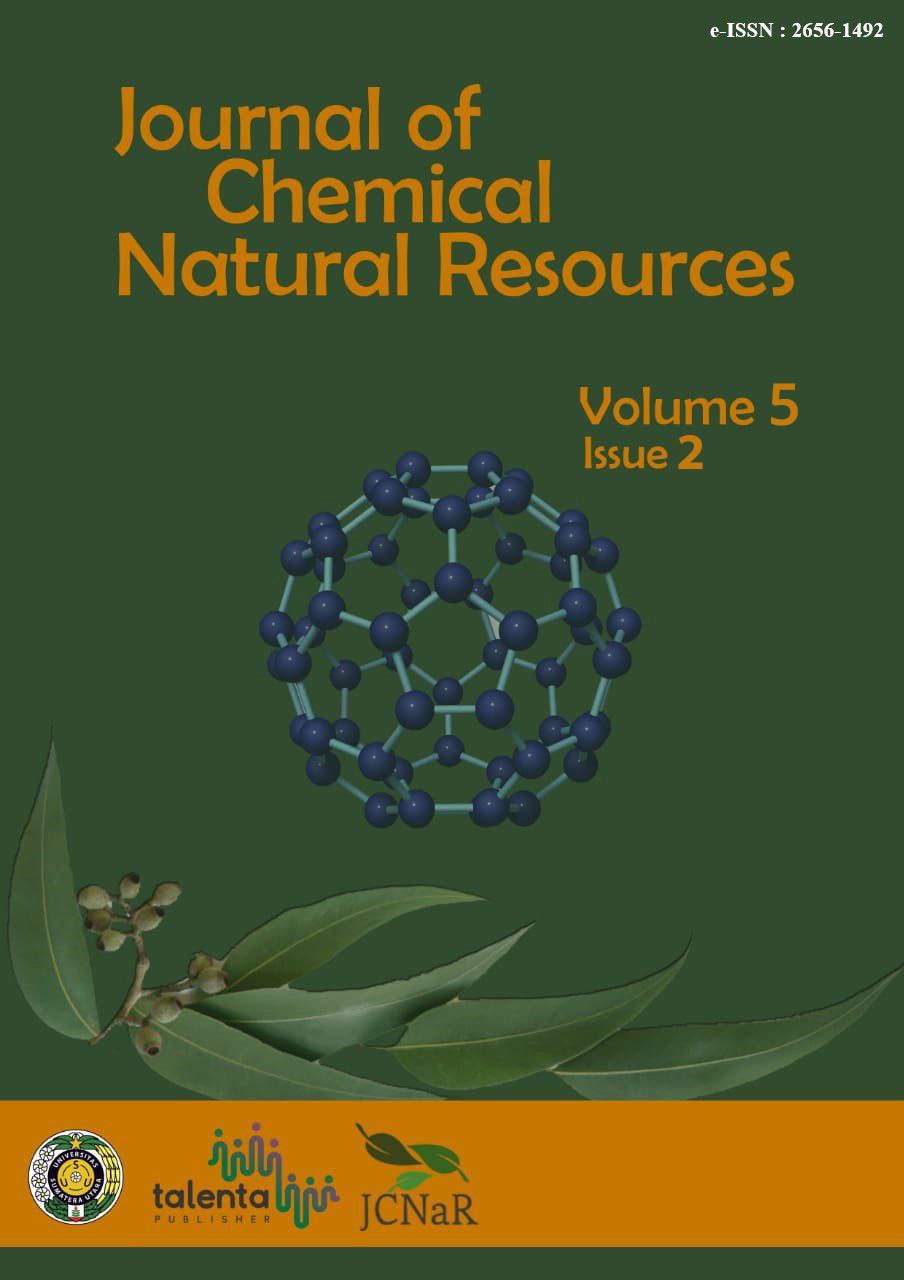Improved Tamarillo (Cyphomandra betacea Sendtn) Fruit Juice Quality with Carboxymethyl Cellulose Extracted from Cassava Peel (Manihot esculenta Crantz)
DOI:
https://doi.org/10.32734/jcnar.v5i2.13811Keywords:
Carboxymethyl Cellulose, Cassava Peel, Cellulose, Fruit JuiceAbstract
The utilization of Carboxymethyl Cellulose (CMC) from cassava peel (Manihot esculenta Crantz) through the quality of Tamarillo (Cyphomandra betacea Sendtn) juice was carried out through three stages. The first stage is α-cellulose isolation from cassava peel powder using an acid method and then comparing it with commercial cellulose using FTIR analysis. The second stage is an α-cellulose conversion into CMC by alkalization (using isopropanol and NaOH), carboxymethylation (using NaMCA), neutralization (using CH3COOH 90% and ethanol), purification (using distilled water followed by centrifugation and the addition of acetone which produces CMC with positive results), and then comparing isolated CMC with commercial CMC by using FTIR analysis. The last stage is Tamarillo fruit juice preparation with and without CMC addition. At this stage, the concentration of CMC was carried from 0%, 0.25%, 0.5%, 0.75%, 1%, and 1.25%. The resultant juice was analyzed for its quality by stability (letting it stand for 24 hours), pH (with a pH meter), viscosity (with an Ostwald viscometer), vitamin C content (using the iodimetry method), antioxidant activity (using the free radical scavenging method with a solution and using a UV-VIS spectrophotometer), and organoleptic (tests on 30 untrained panellists). The best results were obtained from Tamarillo juice containing 1.25% CMC, which has 73% stability, pH 4.49, viscosity of 77.79 cP, vitamin C content of 25.32 mg/100 g and antioxidant activity of 59%. Organoleptic test results showed that fruit juice with the addition of 0.75% CMC was the most preferred result by panellists based on aroma, taste, texture, and color.
Downloads
References
BPOM RI, “Peraturan Badan Pengawas Obat Dan Makanan tentang Bahan Tambahan Pangan Nomor 11 Tahun 2019 Tentang Bahan Tambahan Pangan,†Badan Pengawas Obat dan Makanan Republik Indones., pp. 1–1156, 2019.
Permenkes RI, “PERATURAN MENTERI KESEHATAN REPUBLIK INDONESIA : BAHAN TAMBAHAN MAKANAN,†Jakarta, 2012.
S. Santoso, N. Sanjaya, and A. Ayucitra, “Pemanfaatan Kulit Singkong Sebagai Bahan Baku Pembuatan Natrium Karbosimetil Selulosa,†J. Tek. Kim. Indones., vol. 11, no. 3, pp. 124–131, 2018.
S. D. Yuwono, E. Wahyuningsih, Noviany, A. A. Kiswandono, W. Simanjuntak, and S. Hadi, “Characterization of carboxymethyl cellulose (CMC) synthesized from microcellulose of cassava peel,†Mater. Plast., vol. 57, no. 4, pp. 225–235, 2021, doi: 10.37358/MP.20.4.5422.
M. Rito et al., “Antioxidant Potential of Tamarillo Fruits—Chemical and Infrared Spectroscopy Analysis,†Antioxidants, vol. 12, no. 2, 2023, doi: 10.3390/antiox12020536.
D. Setiadi, “Pengaruh Konsentrasi Karboksimetil Selulosa Terhadap Mutu Sari Buah Jambu Biji,†Ilmu Pertan., vol. 9, no. 1, pp. 28–36, 2002.
J. Clifford, A. Olaf, Runquist, and M. . Malcom, Analisis Spektrum Senyawa Organik. Bandung: Penerbit ITB, 1982.
E. Rahmaningtyas, N. . Yusa, and N. Puspawati, “Pengaruh Penambahan CMC (Carboxyl Methyl Cellulose) Terhadap Karakteristik Sirup Salak Bali (Salacca zalacca var. Amboinensis) Selama Penyimpanan,†Teknol. Pertan. Univ. Udayana, pp. 20–19, 2015.
F. Sebayang, “The Utilization of Carboxymethyl Cellulose (Cmc) from Groundnut (Arachis Hypogaea L) Cellulose as Stabilizer for Cow Milk Yogurt,†J. Chem. Nat. Resour., vol. 1, no. 2, pp. 38–51, 2019, doi: 10.32734/jcnar.v1i2.1252.
S. Akkarachaneeyakorn and S. Tinrat, “Effects of types and amounts of stabilizers on physical and sensory characteristics of cloudy ready-to-drink mulberry fruit juice,†Food Sci. Nutr., vol. 3, no. 3, pp. 213–220, 2015, doi: 10.1002/fsn3.206.
Badan Standarisasi Nasional, “Petunjuk Pengujian Organoleptik dan atau Sensori,†Jakarta, SNI 01-2346-2006. ICS 67.240, 2006.
T. Anggraini, Sumber Antioksidan Alami. Padang: Eka, 2017.

Downloads
Published
Issue
Section
License
Copyright (c) 2023 Journal of Chemical Natural Resources

This work is licensed under a Creative Commons Attribution-ShareAlike 4.0 International License.














